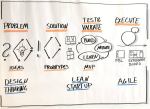“DataOps is the practice of integrating data engineering and data analytics to enable agile development, testing, and deployment of data-driven applications.”
Gartner
DataOps is an emerging methodology and culture that aims to streamline and optimize the processes of collecting, processing, analyzing, and delivering data within an organization. It is a set of practices that emphasizes collaboration, automation, and integration among different teams involved in data management, such as data engineers, data scientists, analysts, and business stakeholders.
DataOps borrows principles and techniques from DevOps, Agile, Lean, and other related fields, and applies them to data operations. The goal is to create a more agile, efficient, and reliable data infrastructure that can support the changing needs of the business and deliver insights faster.
Key Elements Of DataOps
Some key elements of DataOps include:
- Collaboration: DataOps promotes cross-functional collaboration between different teams involved in data management, such as data engineers, data scientists, and business analysts.
- Automation: DataOps relies on automation to reduce the time and effort required for manual tasks and to ensure consistency and reliability in data processing and analysis.
- Continuous integration and delivery: DataOps emphasizes the need for continuous integration and delivery b(CI/CD) of data pipelines and processes, using version control, testing, and monitoring to ensure high quality and rapid feedback.
- Monitoring and observability: DataOps emphasizes the need for real-time monitoring and observability of data pipelines and systems, to detect issues and ensure that data is flowing smoothly.
- Agile methodology: DataOps applies Agile principles to data management, such as prioritizing backlog items, iterative development, and regular retrospectives to improve processes.
By implementing DataOps practices, organizations can achieve faster and more reliable data processing and analysis, and can better support the needs of the business.
DataOps Lifecycle
The DataOps lifecycle allows both data teams and business stakeholders to work together in tandem to deliver more reliable data and analytics to the organization.
Here is what the DataOps lifecycle looks like in practice:

- Planning: Partnering with product, engineering, and business teams to set KPIs, SLAs, and SLIs for the quality and availability of data (more on this in the next section).
- Development: Building the data products and machine learning models that will power your data application.
- Integration: Integrating the code and/or data product within your existing tech and or data stack. (For example, you might integrate a dbt model with Airflow so the dbt module can automatically run.)
- Testing: Testing your data to make sure it matches business logic and meets basic operational thresholds (such as uniqueness of your data or no null values).
- Release: Releasing your data into a test environment.
- Deployment: Merging your data into production.
- Operate: Running your data into applications such as Looker or Tableau dashboards and data loaders that feed machine learning models.
- Monitor: Continuously monitoring and alerting for any anomalies in the data.
This cycle will repeat itself over and over again. However, by applying similar principles of DevOps to data pipelines, data teams can better collaborate to identify, resolve, and even prevent data quality issues from occurring in the first place.
Benefits And Challenges Of DataOps
By adopting DataOps, organizations can improve the speed, quality, and reliability of their data operations, which is essential for making informed decisions and gaining a competitive edge in today’s data-driven economy.
Benefits of DataOps
- Faster time-to-insight: DataOps enables organizations to accelerate the time it takes to turn raw data into valuable insights by automating data pipelines and reducing the time required for data ingestion, cleaning, and transformation.
- Improved data quality: By automating data pipelines, DataOps can help organizations to reduce errors and inconsistencies in data, ensuring that data is accurate, complete, and up-to-date.
- Increased agility: DataOps can help organizations to be more responsive to changing business needs by enabling them to quickly adapt their data pipelines to new data sources or analytical requirements.
- Better collaboration: DataOps encourages collaboration between data engineers, data scientists, and business analysts, which can lead to better decision-making by leveraging the collective expertise of the team.
Challenges of DataOps
- Data complexity: As organizations collect more data from a variety of sources, data pipelines can become increasingly complex and difficult to manage, which can make it challenging to implement DataOps practices.
- Data security and privacy: DataOps requires organizations to manage and process sensitive data, which can raise concerns about data security and privacy.
- Lack of expertise: Implementing DataOps requires specialized skills and knowledge in areas such as data engineering, DevOps, and automation, which can be difficult to find and expensive to hire.
- Cultural barriers: DataOps requires a culture of collaboration and continuous improvement, which can be difficult to achieve in organizations that are siloed or resistant to change.
While DataOps can provide significant benefits to organizations, it also requires careful planning, execution, and ongoing maintenance to ensure that it delivers the expected results.
DataOps Examples
Here are some examples of DataOps:
- Continuous Integration and Continuous Delivery (CI/CD): This approach involves automating the testing and deployment of data pipelines and workflows. This helps ensure that data is processed consistently and errors are caught early.
- Agile Development: DataOps emphasizes an agile approach to development that prioritizes collaboration between data scientists, data engineers, and other stakeholders. This helps ensure that everyone is working towards the same goals and that feedback is integrated quickly.
- Version Control: Version control is a crucial component of DataOps that allows teams to manage changes to data pipelines and workflows over time. This helps ensure that everyone is working with the most up-to-date version of the code and that changes are tracked and auditable.
- Monitoring and Alerting: DataOps involves monitoring data pipelines and workflows to identify issues and anomalies. This can include setting up alerts for data quality issues, data ingestion failures, or other issues that could impact data availability or accuracy.
- Data Governance: DataOps involves implementing data governance practices to ensure that data is accurate, reliable, and compliant with regulatory requirements. This can include implementing data quality checks, data lineage tracking, and data privacy controls.
- Cloud Computing: DataOps can leverage cloud computing platforms to facilitate collaboration, automation, and monitoring. Cloud platforms like AWS, Azure, and GCP provide tools and services that can help streamline DataOps workflows, such as managed data processing services, serverless computing, and automated infrastructure provisioning.
Final Thoughts
DataOps is a data management methodology that combines the principles of Agile software development, DevOps, and Lean manufacturing to streamline the data lifecycle, from data ingestion to delivery. Its goal is to improve the speed, quality, and reliability of data analytics by automating and optimizing the processes involved in data management, including data integration, cleansing, transformation, storage, and analysis.
DataOps also emphasizes collaboration, communication, and continuous improvement among the various stakeholders involved in the data lifecycle, such as data engineers, data scientists, analysts, and business users. By adopting DataOps, organizations can reduce the time-to-insight, increase the accuracy and consistency of data, and drive better business outcomes.
🅐🅚🅖
Interested in Management, Design or Technology Consulting, contact anil.kg.26@gmail.com
Get updates and news on our social channels!
LATEST POSTS
- A Tale Of Two Frameworks: Spring Boot vs. Django
 “Spring Boot’s convention over configuration approach simplifies development, allowing developers… Read more: A Tale Of Two Frameworks: Spring Boot vs. Django
“Spring Boot’s convention over configuration approach simplifies development, allowing developers… Read more: A Tale Of Two Frameworks: Spring Boot vs. Django - Unleashing The Power Of Django
 “Django, akin to a Swiss Army knife, provides a comprehensive… Read more: Unleashing The Power Of Django
“Django, akin to a Swiss Army knife, provides a comprehensive… Read more: Unleashing The Power Of Django - Potential of Progressive Web Apps (PWAs)
 “PWAs are not just about technology; they are about creating… Read more: Potential of Progressive Web Apps (PWAs)
“PWAs are not just about technology; they are about creating… Read more: Potential of Progressive Web Apps (PWAs) - Unleashing The Power Of Spring Framework
 “Spring Framework simplifies enterprise Java development, but it does so… Read more: Unleashing The Power Of Spring Framework
“Spring Framework simplifies enterprise Java development, but it does so… Read more: Unleashing The Power Of Spring Framework - Key Trends Of OSINT In 2024
 “The future of OSINT lies in our ability to adapt… Read more: Key Trends Of OSINT In 2024
“The future of OSINT lies in our ability to adapt… Read more: Key Trends Of OSINT In 2024 - Can Google’s Carbon Language Replace C++?
 “While Carbon may excel in performance-critical domains, it cannot replace… Read more: Can Google’s Carbon Language Replace C++?
“While Carbon may excel in performance-critical domains, it cannot replace… Read more: Can Google’s Carbon Language Replace C++? - Integration of Design Thinking, Lean, and Agile
 “Innovation thrives when Design Thinking, Lean, and Agile converge, creating… Read more: Integration of Design Thinking, Lean, and Agile
“Innovation thrives when Design Thinking, Lean, and Agile converge, creating… Read more: Integration of Design Thinking, Lean, and Agile - Benefits Of Infrastructure as Code (IaC)
 “Infrastructure as Code is the single most important thing you… Read more: Benefits Of Infrastructure as Code (IaC)
“Infrastructure as Code is the single most important thing you… Read more: Benefits Of Infrastructure as Code (IaC) - Power Of Internet of Everything (IoE)
 “The true power of the Intebrnet of Everything lies not… Read more: Power Of Internet of Everything (IoE)
“The true power of the Intebrnet of Everything lies not… Read more: Power Of Internet of Everything (IoE) - How Is The Enterprise IoT Evolving?
 “IoT is not just about connecting things; it’s about connecting… Read more: How Is The Enterprise IoT Evolving?
“IoT is not just about connecting things; it’s about connecting… Read more: How Is The Enterprise IoT Evolving? - IT Pricing Strategy And Models
 “The art of pricing lies in finding the perfect balance… Read more: IT Pricing Strategy And Models
“The art of pricing lies in finding the perfect balance… Read more: IT Pricing Strategy And Models - What Is SYCL (“sickle”)?
 “SYCL provides a powerful and intuitive programming model that simplifies… Read more: What Is SYCL (“sickle”)?
“SYCL provides a powerful and intuitive programming model that simplifies… Read more: What Is SYCL (“sickle”)? - What Is A Data Lakehouse?
 “With a data lakehouse, organizations can break down data silos,… Read more: What Is A Data Lakehouse?
“With a data lakehouse, organizations can break down data silos,… Read more: What Is A Data Lakehouse? - 5G – The Future Of The Internet
 “5G is the next big step in the evolution of… Read more: 5G – The Future Of The Internet
“5G is the next big step in the evolution of… Read more: 5G – The Future Of The Internet - Ransomware Groups Are Switching To Rust
 “Rust is to Ransomware what a lockpick is to a… Read more: Ransomware Groups Are Switching To Rust
“Rust is to Ransomware what a lockpick is to a… Read more: Ransomware Groups Are Switching To Rust - Streaming Data Pipelines
 “A streaming data pipeline is like a river: it flows… Read more: Streaming Data Pipelines
“A streaming data pipeline is like a river: it flows… Read more: Streaming Data Pipelines - Why Rust Is Best?
 “Rust is a systems programming language that runs blazingly fast,… Read more: Why Rust Is Best?
“Rust is a systems programming language that runs blazingly fast,… Read more: Why Rust Is Best? - Database Sharding Explained
 “Database sharding is like breaking a large puzzle into smaller,… Read more: Database Sharding Explained
“Database sharding is like breaking a large puzzle into smaller,… Read more: Database Sharding Explained - Ambient Computing Will Be The Future Tech
 “Ambient computing creates a seamless technology-rich environment, but challenges in… Read more: Ambient Computing Will Be The Future Tech
“Ambient computing creates a seamless technology-rich environment, but challenges in… Read more: Ambient Computing Will Be The Future Tech - Key Trends Of OSINT In 2023
 “OSINT is not just a technique, it’s a mindset. It’s… Read more: Key Trends Of OSINT In 2023
“OSINT is not just a technique, it’s a mindset. It’s… Read more: Key Trends Of OSINT In 2023

